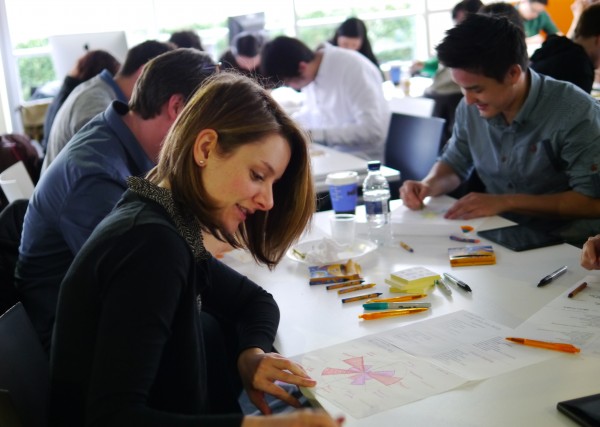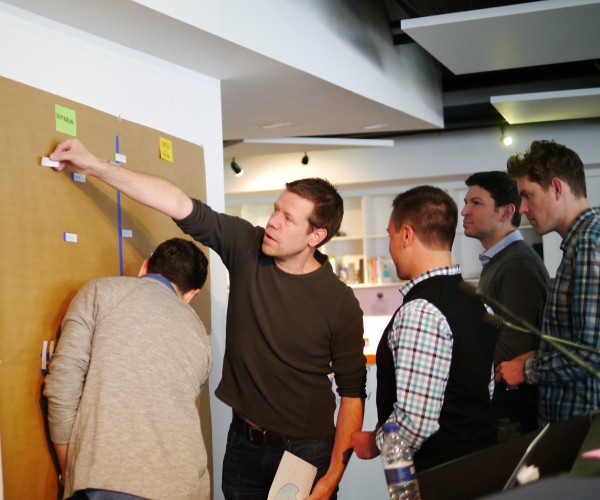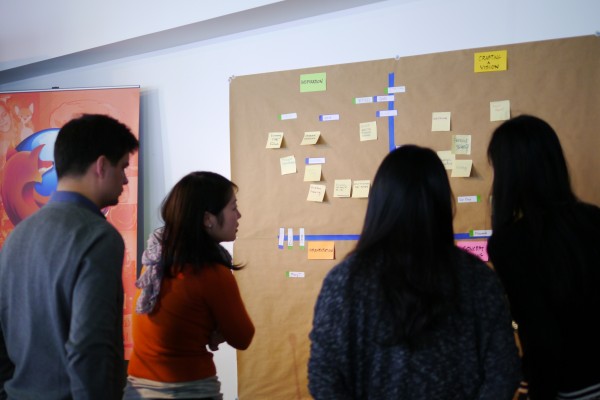A few weeks ago, the entire User Experience Team came together for our UX Summit to reflect on our work and our organization. As part of the week’s activities, I planned and led a day-long workshop around the goal of creating and shipping products that our users love.
Running a successful workshop for a large group of designers, researchers, prototypers, and UX managers who work on different products in Mozilla can be quite a challenge. This is my reflection on how I tried to help a diverse group such as ours discuss common challenges and begin creating a shared process.
Plan activities that are relevant to each person’s work
This suggestion seems obvious, but it’s often overlooked in many workshops, especially ones led by those who don’t know the participants well. It’s not uncommon to learn new skills in a great workshop then realize later on that you have no clue how to integrate that learning into your own product process.
I wanted to make sure that my colleagues would walk away feeling like they had something tangible to take back to the product teams they work with. Thus, many of my activities began with individual (or small team) reflections where I asked everyone to apply a framework or process I put together to their own product experiences. This approach provided us with some common tools and language to evaluate our impact as a UX team, while allowing each person to introspect on his or her own work.

Individual worksheets help our diverse team reflect on specific projects while discussing informally
Not everyone has to speak up to be an active participant
I’ve never liked workshops where each participant is forced to share, one after another. I understand the reasons for doing so (such as allowing each person to be heard, not just the majority voice), but it’s hard to scale this approach, introverts hate being required to speak up, and everyone’s answers tend to be verbose variations on the same theme. Besides, with a diverse organization such as ours, things that are meaningful to one product team can be irrelevant to another.
I still had a large group discussion at the end of each activity, but rather than asking everyone to report out, I made sure that it was only one of multiple ways that people could voice their thoughts and observations to the rest of the team. During the individual reflection portion of an exercise, participants had worksheets that they could fill out alone or talk to others about as they saw fit. This task gave people the opportunity to reflect specifically about the issues they cared about. Afterwards, I also asked each person to contribute their thoughts (on post-its or name tags) to a large group visualization. These maps gave everyone a chance to share their point-of-view and quickly see the bigger organizational picture from everyone else’s contributions.
In the end, I think the balance between reflecting on individual team needs and visualizing patterns within the larger UX organization created a richer discussion about issues that were relevant to the entire group.
Scaffold difficult tasks (don’t shy away from them)
Not every activity in a workshop is going to be easy to explain or easy to do. Some activities are hard because they tap into uncomfortable/sensitive team issues. Others require complex thinking that cannot be compressed into the time you have for the workshop.
For my workshop, I wanted to do a particular activity that I knew was challenging but useful in the long run. So I tried to break it down into smaller tasks that were easier to understand. I also provided written instructions, examples, and worksheets to help my colleagues get started. Despite my preparation, people were still fairly confused in the beginning, but I persisted in explaining the task and why the activity was important, until eventually everyone tried it out. Later on, some participants told me that this challenging activity was one of the most useful components of my workshop for them.
Don’t shy away from activities that challenge the team; they often lead to the most meaningful changes. Instead, acknowledge the difficulty of what you’re asking people to do, give them enough time to do it, and (as cheesy as it sounds) have faith in your team’s ability to figure it out.
Practical Tip: I scheduled my hardest activity about an hour before lunch so that everyone had time to wake up but weren’t sluggish from having eaten or exhausted from thinking. I think the promise of a lunch break encouraged people to power through the challenging task. (Just don’t end late for lunch, or else you will have some very unhappy participants!)
C’est La Vie
I’m a planner so I spend a lot of time preparing for the workshops I lead. Planning the right activities and making sure they run smoothly ensure that a workshop meets its goals and isn’t just a waste of time for everyone involved.
But it’s also important to remember that a successful workshop isn’t one where you hit every bullet point in your agenda; it’s one where the participants get something valuable out of the time they spend with you. As a facilitator, you have to be responsive to the needs of the group as the workshop progresses. Let the discussion go longer if everyone’s energy seems to be there. Cut the activity short if people look like they’ve checked out. If it seems like the group isn’t getting to insights, modify the activity on the fly so that they do.
During breaks and individual activities, I like to get the temperature of the room by talking to individuals and seeing whether they still find the exercises relevant for their particular group. As much as I try to plan beforehand, my activities can still be slightly biased towards an interaction designer’s perspective. It’s important that I check my own assumptions about what other disciplines within the UX team need.
As a parting thought, remember that your workshop isn’t and shouldn’t be the only opportunity you have to accomplish whatever goals you set. Instead, it’s a starting point for later conversations and activities with individuals and smaller teams. The art of facilitating the workshop is in figuring out where to focus the group’s energy so that you build that great starting point for change to ripple through your organization.

